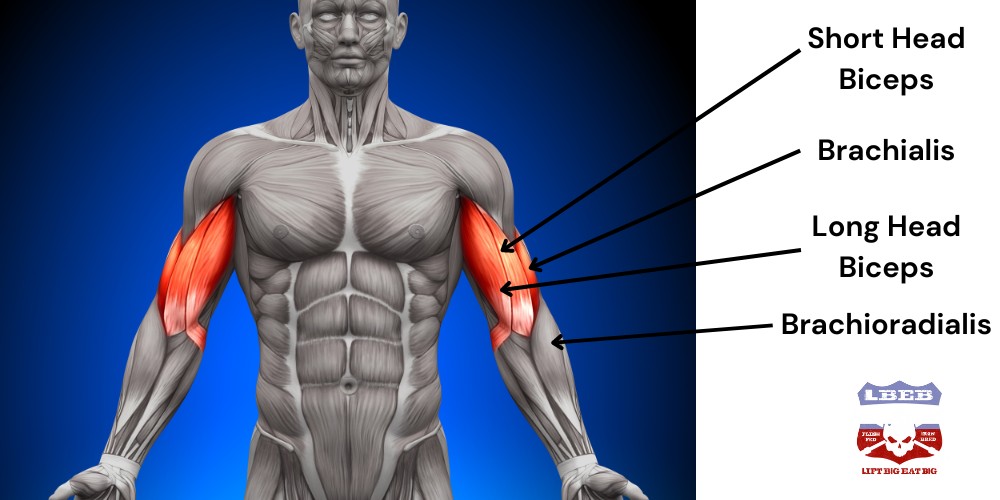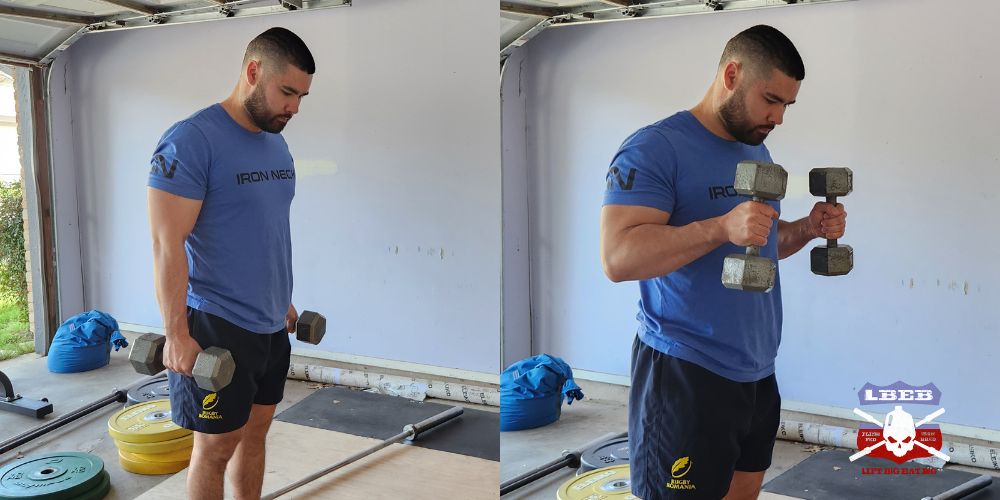The biceps are a relatively simple muscle group to train. Most gym bros perform an endless number of curls to develop them. But there are slight nuances between exercises like the hammer curl and bicep curl that you must know when maximizing biceps development.
The hammer curl uses a semi-pronated or neutral grip, whereas the bicep curl uses a supinated or underhand grip. The hammer curl targets the brachialis muscle, and the bicep curl targets the biceps brachii.
But do you need to do both curls, and when should you do them? Further, these aren’t the only differences!
Table of Contents
What Is The Hammer Curl?
The hammer curl is a bicep curl but with a neutral or semi-pronated grip. This position is having your palms facing each other. The hammer curl is your strongest bicep curl exercise because of the strong brachialis muscle. That doesn’t mean the hammer curl doesn’t hit the biceps brachii.
The neutral position increases activation of the short head of the biceps [3]. Here’s how to do it:
- Standing with dumbbells by your side and palms facing your body, curl the dumbbells while maintaining your shoulder position.
- Squeeze your biceps in the shortened position and slowly return to the starting position.
What Is The Bicep Curl?
An underhand or supinated grip categorizes the bicep curl. Barbells, dumbbells, EZ bars, kettlebells, and straight bar cable attachments are all used to perform the bicep curl. The supinated position increases muscle activation of the biceps long head [3]. Here’s how to do it:
- Hold the dumbbells by your side with your palms facing up. Make sure your arms are extended in this position.
- Curl the dumbbells to approximately chest height squeezing your biceps. You can add a slight shoulder flexion at the end for further biceps shortening.
- Slowly extend the elbow returning to the starting position.
Hammer Curl vs. Bicep Curl: What’s The Difference?
Technique
The hammer and bicep curl denotes the hand position when performing the curl. The hammer curl uses a neutral grip (semi-pronated), while the bicep curl uses an underhand grip (supinated). The hammer curl can be performed using a short bar with neutral handles, dumbbells, or rope cable attachment.
The bicep curl can be performed with anything that allows a supinated hand position, such as the barbell, EZ bar, dumbbells, and cable attachments. One small technique difference is the bicep curl can be slightly enhanced by adding shoulder flexion as the biceps brachii flex the elbow and shoulder.
Because the brachialis muscle only crosses the elbow joint, your shoulder position is not as important.
Muscles Worked
The reason for using the hammer and bicep curl is to target different muscles of the biceps. Here is basic biceps anatomy to help you understand this:

The biceps brachii are made of two muscle heads:
- Short head
- Long head
Both heads originate at the shoulder and insert on the radius bone in the outer forearm [1]. The primary function of the biceps is to flex the elbow and supinate the forearm. They also help flex the shoulder. The biceps brachii elicit the greatest muscle activation when the forearm is supinated.
But the brachialis muscle is the strongest elbow flexor and is targeted with a neutral hand position [4]. It originates on the bottom of the upper arm and inserts on the ulnar bone in the inner forearm. Its primary function is elbow flexion [2].
Therefore, the bicep curl primarily targets the short and long-head biceps brachii, and the hammer curl primarily targets the brachialis muscle.
Weight Used
The final difference between bicep and hammer curls is the loads you can use. You are much stronger with the hammer curl, as the brachialis is the strongest elbow flexor. In my experience, I can curl approximately 25% more weight with the hammer curl than with the bicep curl.
Are Hammer Curls Better Than Bicep Curls?

No curl is better than the other, so hammer curls are not better than bicep curls. What may be needed for overall biceps development differs between individuals. For example, bodybuilders often use the bicep curl to develop the biceps “peak.”
When looking from the side, the hammer curl will add overall thickness to the upper arms. Only focusing on one bicep curl variation will limit your biceps and arm development.
Should You Do Both Hammer Curls And Bicep Curls?
You should do hammer curls and biceps curls within your training program if your goal is to get bigger biceps. If you only did bicep curls, you would underdevelop the brachialis muscle. Further, varying your hand position will keep your elbows healthy.
Hammer Curl vs. Bicep Curl: When Should You Do Each?
There are multiple ways to program hammer and bicep curls within your training program. The first option is to perform both within the same workout. For example, if you perform an arm day or biceps at the end of a back day, you can do 2-4 sets of hammer curls followed by 2-4 sets of bicep curls.
You can also reverse this order depending on your priority. Another option is to train the biceps twice a week and have one day focused on hammer grip bicep variations. The other focused on supinated grip biceps curls.
Finally, you could vary the grip by training cycle. For example, spending 4 weeks using hammer variations and training the biceps with an underhand grip using chin-ups. Then next cycle, use bicep curls and neutral grip chin-ups for the brachialis.
Summary
The hammer curl and bicep curl preferentially target different muscles in the upper arm. Use both variations for complete arm development. If you’re going through a phase of training where you’re getting maximum pumps, you can superset the hammer curl with the bicep curl for skin-splitting biceps.
References
1. Tiwana, M. S., Charlick, M., & Varacallo, M. (2018). Anatomy, shoulder and upper limb, biceps muscle.
2. Plantz, M. A., Bordoni, B. (2022). Anatomy, Shoulder and Upper Limb, Brachialis Muscle.
3. Jarrett, C. D., Weir, D. M., Stuffmann, E. S., Jain, S., Miller, M. C., & Schmidt, C. C. (2012). Anatomic and biomechanical analysis of the short and long head components of the distal biceps tendon. Journal of shoulder and elbow surgery, 21(7), 942-948.
4. NAITO, A., YAJIMA, M., FUKAMACHI, H., USHIKOSHI, K., SUN, Y. J., & SHIMIZU, Y. (1995). Electromyographic (EMG) study of the elbow flexors during supination and pronation of the forearm. The Tohoku journal of experimental medicine, 175(4), 285-288.
